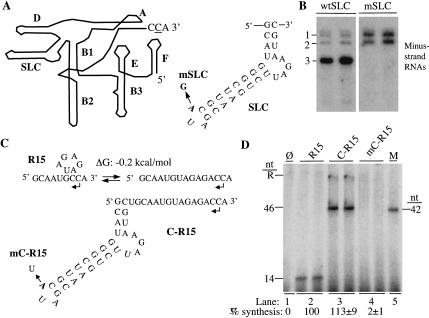FIGURE 1.
BMV RNA synthesis in vivo and in vitro. (A) Schematic of the BMV 3′ ∼190 nt, which functionally mimics a tRNA-like sequence. The structure is modeled after the one in Fechter et al. (2001). The names of the various stem-loops are in bold letters from A to F, except for SLC. The sequence and secondary structure of SLC is shown to the right of the schematic. The name mSLC denotes an RNA3 with mutation in the CAM. (B) Northern blot result demonstrating that BMV RNA3 with a single-nucleotide change in the CAM of SLC is unable to direct RNA synthesis in transfected barley protoplasts despite having a wild-type initiation CCA sequence. As will be the case for all of the figures, most results will be shown in duplicate, independent reactions to demonstrate reproducibility. Lanes labeled “wtSLC” contain RNA from protoplasts transfected with wild-type transcripts of the three BMV RNAs. Lanes labeled “mSLC” were from protoplasts transfected with wild-type BMV RNA1 and RNA2 and RNA3 with the mSLC mutation. The RNAs were probed to detect minus-strand BMV RNAs. Probing with a probe recognizing cellular 18S rRNA revealed that all lanes contained comparable amounts of RNA (data not shown). The numbers to the left of the autoradiogram identifies the minus-strand RNAs in the Northern blot. (C) Schematics of R15, a relatively unstructured RNA that could potentially exist in two conformations in solution, and C-R15, which contains SLC fused 5′ of R15. mC-R15 contains a single nucleotide change at the CAM. (D) RNA synthesis by the BMV replicase from the templates shown in (C). Qualitative results for all reactions were run in duplicate in the autoradiogram to demonstrate reproducibility of the results. “φ” denotes a reaction performed in the absence of exogenously provided RNA. The products from C-R15 contain both the template-length product (46 nt) and a putative recombinational dimeric product (R) similar to the ones previously observed in M.J. Kim and Kao (2001). The lengths of the products were determined by comparison to the previously characterized products from SLC+8 (Kim et al. 2000) and −20/13 (Siegel et al. 1998). Quantifications of the 14- and 46-nt RNAs synthesized from three independent reactions are shown below the autoradiogram. All quantifications were normalized for the number of radiolabled cytidylates incorporated relative to the control and are from two independent assays.

